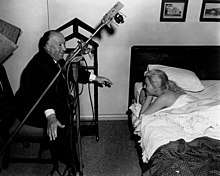Madonna–whore complex
In psychoanalytic literature, a Madonna–Whore Complex is the inability to maintain sexual arousal within a committed, loving relationship.[1] First identified by Sigmund Freud, under the rubric of psychic impotence,[2] this psychological complex is said to develop in men who see women as either saintly Madonnas or debased prostitutes. Men with this complex desire a sexual partner who has been degraded (the whore) while they cannot desire the respected partner (the Madonna).[3] Freud wrote: "Where such men love they have no desire and where they desire they cannot love."[4] Clinical psychologist Uwe Hartmann, writing in 2009, stated that the complex "is still highly prevalent in today's patients".[3]

The term is also used popularly, if sometimes with subtly different meanings.
Causes
Freud argued that the Madonna–whore complex was caused by a split between the affectionate and the sexual currents in male desire.[5] Oedipal and castration anxiety fears prohibit the affection felt for past incestuous objects from being attached to women who are sensually desired: "The whole sphere of love in such persons remains divided in the two directions personified in art as sacred and profane (or animal) love".[5] In order to minimize anxiety, the man categorizes women into two groups: women he can admire and women he finds sexually attractive. Whereas the man loves women in the former category, he despises and devalues the latter group.[6] Psychoanalyst Richard Tuch suggests that Freud offered at least one alternative explanation for the Madonna–whore complex:
This earlier theory is based not on oedipal-based castration anxiety but on man's primary hatred of women, stimulated by the child's sense that he had been made to experience intolerable frustration and/or narcissistic injury at the hands of his mother. According to this theory, in adulthood the boy-turned-man seeks to avenge these mistreatments through sadistic attacks on women who are stand-ins for mother.[6]
It is possible that such a split may be exacerbated when the sufferer is raised by a cold but overprotective mother[7] – a lack of emotional nurturing paradoxically strengthening an incestuous tie.[8] Such a man will often court someone with maternal qualities, hoping to fulfill a need for maternal intimacy unmet in childhood, only for a return of the repressed feelings surrounding the earlier relationship to prevent sexual satisfaction in the new.[5]
Another theory claims that the Madonna–whore complex derives from the representations of women as either madonnas or whores in mythology and Judeo-Christian theology rather than developmental disabilities of individual men.[9]
Sexual politics
Naomi Wolf considered that the sexual revolution had paradoxically intensified the importance of the virgin–whore split, leaving women to contend with the worst aspects of both images.[10] Others consider that both men and women find integrating sensuality and an ideal femininity difficult to do within the same relationship.[11]
In popular culture

- James Joyce widely utilized the Madonna-whore polarity in his novel A Portrait of the Artist as a Young Man.[12] His protagonist, Stephen Daedalus, sees girls who he admires as ivory towers, and the repression of his sexual feelings for them eventually leads him to solicit a prostitute. This mortal sin drives Stephen's inner conflict and eventual transformation towards the end of the novel.
- Alfred Hitchcock used the Madonna–whore dichotomy as an important mode of representing women.[13] In Vertigo (1958), for example, Kim Novak portrays two women that the hero cannot reconcile: a virtuous, blonde, sophisticated, sexually repressed "madonna" and a dark-haired, single, sensual "fallen woman".[14]
- Pamela Thurschwell highlighted "the range of [Bob] Dylan's women, which may often begin with a fine line in madonnas and whores but which often go on to undercut each other in spectacular reversals".[15]
- The Martin Scorsese films, Taxi Driver and Raging Bull, feature sexually obsessed protagonists, both played by Robert De Niro, who exhibit the Madonna–whore complex with the women they interact with.[16]
- Sex and the City mentioned Madonna–whore when describing Trey (played by Kyle MacLachlan) and Charlotte's (played by Kristin Davis) sex-life after they got married. Trey was unable to maintain an erection whenever trying to have sex with Charlotte due to the Madonna–whore complex. Charlotte was able to change that by touching herself in front of him.
- In the Seinfeld episode The Sponge, Jerry is unsure how he will have sex with his new girlfriend Lena, on account of her being a charitable and wholesome person.
- In American Horror Story: Asylum, set in a mental asylum during the 1960s, a time when the field of psychoanalysis was in chaos, the repressed character Dr. Arthur Arden, as portrayed by James Cromwell, is fixated on a seemingly innocent and virtuous nun. When she later sexually propositions him, he bitterly defaces and then destroys a statue of the Virgin Mary (a.k.a. the Madonna), screaming "Whore!" at it accusingly. Earlier in the series, Arden had shown to subscribe to Freudian theory regarding feminine sexuality.
- In The Handmaid's Tale, women are strictly categorised and forced to wear a uniform of a specified colour, representative of their status as "Madonna" or "whore". The Handmaids, who are disrespected and violated continually, are made to wear red, which is associated with sex and fertility; the protagonist, a nameless Handmaid, is objectified and abused by the Commander, Fred. In contrast, the wives wear blue which is reminiscent of the virgin Mary; Serena, Fred's wife, doesn't get the attention she wants from her husband.[17]
See also
- Ambivalence
- Coolidge effect
- Dichotomy
- Female Chauvinist Pigs
- Friend zone
- Gender norms in abstinence-only sex education
- Love–hate relationship
- Machismo
- Marianismo
- Misogyny
- Neo-Freudian
- Psychoanalytic concepts of love and hate
- Sexism
- Splitting (psychology)
References
- Kaplan, Helen Singer (1988). "Intimacy disorders and sexual panic states". Journal of Sex & Marital Therapy. 14 (1): 3–12. doi:10.1080/00926238808403902. PMID 3398061.
- W. M. Bernstein, A Basic Theory of Neuropsychoanalysis (2011) p. 106
- Hartmann, Uwe (2009). "Sigmund Freud and His Impact on Our Understanding of Male Sexual Dysfunction". The Journal of Sexual Medicine. 6 (8): 2332–2339. doi:10.1111/j.1743-6109.2009.01332.x. PMID 19493285.
- Freud, Sigmund (1912). "Über die allgemeinste Erniedrigung des Liebeslebens" [The most prevalent form of degradation in erotic life]. Jahrbuch für Psychoanalytische und Psychopathologische Forschungen. 4: 40–50.
- Sigmund Freud, On Sexuality (PFL 7) p. 251
- Tuch, Richard (2010). "Murder on the Mind: Tyrannical Power and Other Points along the Perverse Spectrum". The International Journal of Psychoanalysis 91 (1): 141-162. doi:10.1111/j.1745-8315.2009.00220.x.
- P. A Sacco, Madonna Complex (2011) p. 48
- Neville Symington, Narcissism (1993) p. 99
- Feinman, Clarice. Women in the criminal justice system. Westport, CT: Praeger, 1994, pp. 3–4, ISBN 978-0-275-94486-5.
- Naomi Wolf, Promiscuities (1997) p. 5 and p. 131
- Robert Bly/Marion Woodman, The Maiden King (1999) p. 203
- Wegner, Taylor (2018). Gender Performance and Identity Formation in A Portrait of the Artist as a Young Man. University of Illinois at Urbana-Champaign. p. 118.
- Gay, Volney P. (2001). Joy and the Objects of Psychoanalysis: Literature, Belief, and Neurosis. SUNY series in psychoanalysis and culture. Albany: State University of New York Press. p. 109. ISBN 978-0-7914-5099-4.
- Gordon, Paul. Dial "M" for Mother: A Freudian Hitchcock. Madison, NJ: Fairleigh Dickinson University Press, 2008, pp. 89–91, ISBN 978-0-8386-4133-0.
- Quoted in N. Corcoran ed., Do You, Mr Jones? (2002) p. 269
- Ebert, R. (1976, 7 maart). Interview with Martin Scorsese | Interviews | Roger Ebert. https://www.rogerebert.com/interviews/interview-with-martin-scorsese
- ScreenPrism (2018-05-10), The Handmaid's Tale is About the Present, retrieved 2018-06-12
Further reading
- Freud, Sigmund (1957). "A Special Type of Choice of Object Made by Men, pages 165–175". The Standard Edition of the Complete Psychological Works of Sigmund Freud. XI. London: Hogarth Press. pp. 179–190. ISBN 978-0-7012-0067-1.
On the Universal Tendency of Debasement in the Sphere of Love
External links
- Rotem Kahalon; Orly Bareket; Andrea C. Vial; Nora Sassenhagen; Julia C. Becker; Nurit Shnabel (May 2, 2019). "The Madonna-Whore Dichotomy Is Associated With Patriarchy Endorsement: Evidence From Israel, the United States, and Germany". Psychology of Women Quarterly. 43 (3): 348–367. doi:10.1177/0361684319843298.
- Orly Bareket; Rotem Kahalon; Nurit Shnabel; Peter Glick (November 2018). "The Madonna-whore dichotomy reflects men's support for patriarchy but reduces their sexual and relationship satisfaction". Sex Roles. 79 (9): 519–532. doi:10.1007/s11199-018-0895-7.